Polyclonal origin and hair induction ability of dermal papillae in neonatal and adult mouse back skin
June 2012
in “Developmental Biology”
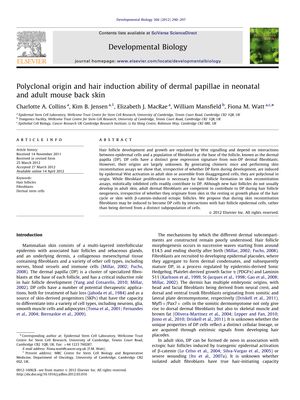
TLDR Dermal papillae cells, important for hair growth, come from multiple cell lines and can be formed by skin cells, regardless of their origin or hair cycle phase. These cells rarely divide, but their ability to shape tissue may contribute to their efficiency in inducing hair growth.
In 2012, a study investigated the origins and hair growth induction ability of dermal papillae (DP), cells crucial for hair growth. The researchers found that DP cells are polyclonal, originating from multiple cell lines, and this was consistent regardless of how the DP formed. The study also discovered that adult dermal fibroblasts, skin cells, can contribute to DP during hair follicle formation, irrespective of their origin from skin in different phases of the hair cycle. The researchers suggested that fibroblasts might be induced to become DP cells through interactions with hair follicle epidermal cells. The study also indicated that DP formation might not rely on cell proliferation, as DP cells rarely divide. Instead, the hair growth induction efficiency of DP cells could be due to their morphogenetic capacity. The study also found that fibroblasts from various skin conditions could contribute to DP formation. The researchers concluded that further investigation into dermal cell heterogeneity was needed.
View this study on doi.org →
Cited in this study
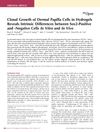
research Clonal Growth of Dermal Papilla Cells in Hydrogels Reveals Intrinsic Differences between Sox2-Positive and -Negative Cells In Vitro and In Vivo
Sox2-positive dermal papilla cells have unique characteristics and contribute more to skin and hair follicle formation than Sox2-negative cells.

research Reprogramming adult dermis to a neonatal state through epidermal activation of β-catenin
Activating a protein called β-catenin in adult skin can make it behave like young skin, potentially helping with skin aging and hair loss.
research Convergent Genesis of an Adult Neural Crest-Like Dermal Stem Cell from Distinct Developmental Origins
Skin-derived precursors in hair follicles come from different origins but function similarly.
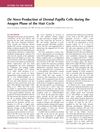
research De Novo Production of Dermal Papilla Cells during the Anagen Phase of the Hair Cycle
New cells are added to the hair's dermal papilla during the active growth phase.
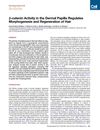
research β-catenin Activity in the Dermal Papilla Regulates Morphogenesis and Regeneration of Hair
β-catenin in the dermal papilla is crucial for normal hair growth and repair.

research Review of hair follicle dermal cells
Dermal cells are key in controlling hair growth and could potentially be used in hair loss treatments, but more research is needed to improve hair regeneration methods.
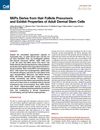
research SKPs Derive from Hair Follicle Precursors and Exhibit Properties of Adult Dermal Stem Cells
SKPs are similar to adult skin stem cells and could help in skin repair and hair growth.

research Laminin-511 is an epithelial message promoting dermal papilla development and function during early hair morphogenesis
Laminin-511 is crucial for early hair growth and maintaining important hair development signals.

research Wnt-dependent de novo hair follicle regeneration in adult mouse skin after wounding
Hair follicles can regrow in wounded adult mouse skin using a process like embryo development.
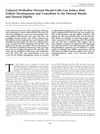
research Cultured Peribulbar Dermal Sheath Cells Can Induce Hair Follicle Development and Contribute to the Dermal Sheath and Dermal Papilla
Certain cells from hair follicles can create new hair and contribute to hair growth when implanted in mice.
research Molecular Mechanisms Regulating Hair Follicle Development
Understanding hair follicle development can help treat hair loss, skin regeneration, and certain skin cancers.

research Hair matrix germinative epidermal cells confer follicle-inducing capabilities on dermal sheath and high passage papilla cells
Hair growth can be stimulated by combining certain skin cells, which can rejuvenate old cells and cause them to specialize in hair follicle creation.
Related

research KY19382, a novel activator of Wnt/β-catenin signaling, promotes hair re-growth and hair follicle neogenesis
KY19382 helps to regrow hair and create new hair follicles.

research Inhibition of β-catenin signalling in dermal fibroblasts enhances hair follicle regeneration during wound healing
Blocking β-catenin in skin cells improves hair growth during wound healing.

research Polyclonal origin and hair induction ability of dermal papillae in neonatal and adult mouse back skin
Dermal papillae cells, important for hair growth, come from multiple cell lines and can be formed by skin cells, regardless of their origin or hair cycle phase. These cells rarely divide, but their ability to shape tissue may contribute to their efficiency in inducing hair growth.
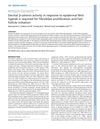
research Dermal β-catenin activity in response to epidermal Wnt ligands is required for fibroblast proliferation and hair follicle initiation
Skin needs dermal β-catenin activity for hair growth and skin cell multiplication.

research β-catenin Activity in the Dermal Papilla Regulates Morphogenesis and Regeneration of Hair
β-catenin in the dermal papilla is crucial for normal hair growth and repair.
research An estrogen receptor pathway regulates the telogen-anagen hair follicle transition and influences epidermal cell proliferation.
Estrogen affects hair growth and skin cell multiplication.

research Hair matrix germinative epidermal cells confer follicle-inducing capabilities on dermal sheath and high passage papilla cells
Hair growth can be stimulated by combining certain skin cells, which can rejuvenate old cells and cause them to specialize in hair follicle creation.